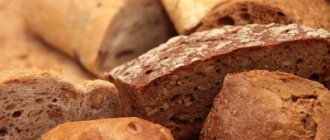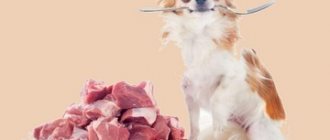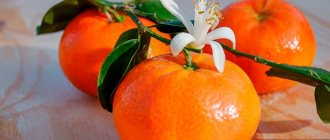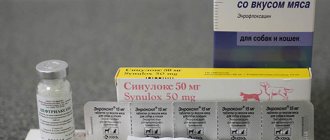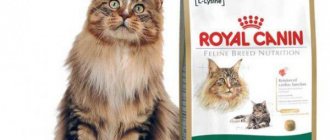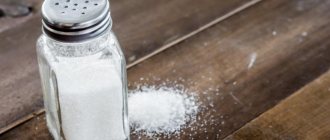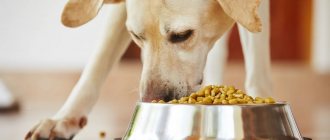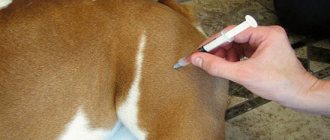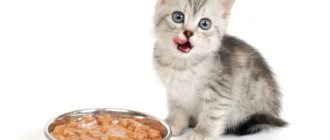Features of the diet of dogs and cats
Zoologists know that dogs are carnivores, and cats are carnivores, despite their common carnivores. Differences are observed both in physiology and in the type of metabolism: a cat (due to the high proportion of glucose in the blood) eats little and often, and a dog eats twice a day (and even once a day).
Cat food must contain taurine, an amino acid that helps digest fats in the small intestine. Taurine is found in beef and fish (there is a lot of it in cod), but is absent in plants. The dog's body itself synthesizes taurine from a pair of amino acids (cysteine and methionine) found in animal protein.
Feeding behavior of a cat
During evolution, the diet of cats consisted primarily of animal fats and proteins. The cat (by its feeding pattern and behavior) is an unconditional predator with some dietary characteristics:
- dependence on arginine - this amino acid is present exclusively in proteins of animal origin;
- need for taurine - lack of amino acid leads to deterioration of vision, disruption of the cardiovascular, reproductive and nervous systems;
- need for arachidonic acid - it is found only in animal fats.
A cat is able to enjoy the process of eating, since its ancestors killed game for themselves, dined slowly and for a long time. That is why the cat is shown fractional feeding - she will decide for herself when to approach the cup. In cats (with the exception of castrated individuals), “food brakes” work: food in the bowl should be freely available. In this situation, a dog will get fat, a healthy cat will not.
Important! Cats, unlike dogs, disdain carrion. The cat will ignore food that has been standing for several hours until the owner replaces it with fresh food.
A cat feels its body more subtly than a dog, and often arranges fasting days itself. If fasting continues for more than 2 days, this is a reason to contact a veterinarian.
Dog's eating behavior
Dogs are irresistibly drawn to carrion, which cannot be considered an anomaly: in the wild, predators often return to carcasses that have become thoroughly rotten. True, carrion picked up by a dog in the city often becomes the cause of gastrointestinal ailments. Another strange food habit of dogs is eating feces, which is considered acceptable for animals under one year of age, as well as for lactating bitches who eat feces (with remnants of undigested food) from their puppies.
In other cases, this signals disorders in the gastrointestinal tract, including problems with the pancreas, and threatens infectious/parasitic diseases (if feces were left by an infected animal). In addition, it is very important for a domestic dog to chew large “sugar” bones (not tubular bones!). Moles contain calcium and also train/strengthen a dog's teeth and gums.
Return to content
Is it possible for dogs?
Everything is individual and situational. Cat food contains a lot of protein, which can slow down your dog's digestion process. But if your pet is active, then his body needs just this amount of protein. Another question is whether the dog’s body can digest fish and salty foods?
REFERENCE! We often hear that if a dog eats something, then its body needs it. Let's remember that dogs eat out of garbage cans out of curiosity. Like all animals, they explore the world around them and try something new. This factor is inherent in all living beings; it can solve the problem of lack of food in difficult times.
In other words, if a dog tasted trash food during a period of famine and concluded that it helped it survive, this information will be passed on to future generations, continuing the family line and increasing the chances of interspecific competition.
If your pet has consumed cat food once, it may cause minor changes in digestion, but will not lead to serious problems.
In cases of systematic use, the gastrointestinal tract will sooner or later adapt to digesting these products.
But this does not always happen, keep an eye on your pet’s feces and condition; if you notice that his behavior and well-being have changed for the worse, you need to stop feeding him cat food and take him to a veterinary clinic.
If there is no other
If you are standing in front of a shelf where only cat food remains, then choose based on the following factors:
- Lack of cheap ingredients (soy, flour, vegetable by-products).
- Look at the price. It is better to take a small package of premium quality so as not to risk your pet’s health.
- They also produce meat food and various assorted food for cats. Choose food without fish or salt.
- Pay attention to the amount of protein, it should not exceed 15-20 grams per 100 grams of dry product.
- If it contains taurine, such food can be given, but in smaller quantities, since taurine is produced by the dog’s body and has a feedback mechanism with histamine. The more taurine, the less histamine. This means that in the event of an allergy, external signs (scabies, rash, hair loss) will not appear, but the internal ones will occur in full. This is dangerous because it can lead a latent disease to an advanced stage, which will be more difficult to cure.
Difference between cat and dog food
Industrial lines of cat and dog food differ both in the selection of basic nutritional ingredients and in their vitamin and mineral composition.
Nutritional Components
Quality pet products include the optimal amount of fats, carbohydrates and proteins to suit the different needs of dogs and cats.
Important! The percentage of fat in dog and cat food is approximately the same, but for cats (keeping in mind their exceptional carnivory), manufacturers add more animal proteins.
Products for dogs contain approximately 15–25% animal proteins, while cat products contain at least 40–70%. Also, cat food is somewhat higher in calories (it contains more carbohydrates), which is explained by the feline's intense metabolism.
Vitamins and minerals
Taurine, iodine and phosphorus are certainly added to high-quality cat food, and a little more calcium and magnesium to dog food. Granules for dogs contain an increased percentage of vitamins A, D3 and C, while the ready-made diet for cats is enriched with vitamins PP and E.
Manufacturers ensure that cat food contains vitamin H, and dog food contains vitamin K. All factory-made dog/cat food contains synthesized vitamins A, B, C and E.
Return to content
Does a cat need fat?
Owners are wary of fat in their cat’s diet, especially if the cat is prone to obesity. But in reality, fat alone will not make a predator fat, just as greens do not make herbivores green. An animal gains excess weight not because of specific macronutrients, but because the total caloric content of the diet is exceeded. If a high-fat food contains a minimum of carbohydrates and is dosed correctly, the cat will be in excellent shape.
Domestic dogs have partly adapted to extract energy from carbohydrates, so dog foods sometimes contain less animal fat and more grains. By consuming such a product regularly, cats will receive less of the essential arachidonic acid, which affects the health of the reproductive, gastrointestinal and other systems. In addition, vitamin A (retinol) is fat-soluble, and if it is not fully absorbed by the cat’s body, it will lead to decreased vision, hair loss, and in the case of kittens, growth retardation.
Why does a dog eat cat food?
There may be many reasons contributing to this deviation, but one of the main ones is the protein hunger that your dog experiences. Most likely, he does not receive enough animal proteins along with his food, which is why he tries to make up for their lack by looking into the cat's bowl. Dogs' interest in cat food is also due to the attractive smell of the latter. As a rule, the animal’s olfactory receptors are affected by economy-class granules, generously flavored with taste enhancers and flavorings.
Important! Remember that inexpensive cat food creates addiction not only in cats, but also in dogs. Animals require certain food and refuse other food.
We cannot exclude greed, which often (if it is not stopped in time) turns into food aggression. The invader instinct is demonstrated by dogs that were deprived of maternal attention in childhood, or by dominant animals. There are several other factors that explain a dog's desire to eat cat food:
- unplanned and unhealthy snacks;
- food is freely available;
- low quality dog food;
- poorly prepared food (cold/hot, tasteless, hard or undercooked);
- change in food habits due to lack of necessary exercise.
Puppies and young dogs periodically steal cat food simply because they finish their portions very quickly. Sometimes natural curiosity or the belief that your neighbor’s food tastes better pushes you to explore someone else’s bowl. To be on the safe side, it is still recommended to visit a doctor who will clarify the reasons for the dog’s interest in cat food.
Return to content
How to stop a dog from eating cat food?
Despite the fact that your dog loves this treat, it is necessary to wean him off it. What should be done?
No matter how much you love your dog, remember that no pet has ever said goodbye to this world with a bowl full of food. If you offer her other food, she will soon begin to try it. But you need to remember a few rules when transferring your pet to another diet:
- The dog should not be allowed to overeat.
- Feed your cat and dog separately.
- Never give cat food.
- Don't skimp on treats.
- Do not give cold and tasteless food.
- If it's dog food, it shouldn't be of good quality.
- Do more physical activity with your dog, so it will become more hungry and will eat what is offered.
- Be sure to visit a veterinarian and find out everything about your dog's health.
You can wean off cat food gradually, that is, mix it with other food, but reduce the dosage every day.
If you care about your pet, then ask yourself: is it possible to give your dog cat food? Think about the fact that she is also a living being and is not immune from all kinds of diseases.
Is cat food bad for dogs?
Negative consequences for the body can arise both from a deficiency and from an excess of some nutritional elements, arranged according to the energy expenditure of cats. Industrial products for cats are higher in calories than dog food, which leads (if used systematically) to gaining extra pounds . In addition, the dog’s body (which produces taurine on its own) does not need to be supplied from the outside.
Excess taurine ingested through cat food can cause heart failure, such as cardiomyopathy.
Important! The danger also lies in the increased acidity of cat food, which is beneficial for cats, but harmful for dogs. Their pancreas loses its rhythm, and pets develop heartburn, gastritis and even ulcers.
Cat food is also contraindicated for puppies whose musculoskeletal system is developing: an unbalanced diet delays and distorts development. Perhaps the main threat lies in the increased concentration of protein, leading to a whole range of canine ailments, such as:
- conjunctivitis;
- otitis;
- dermatitis, including allergic;
- seborrhea;
- renal failure;
- liver diseases;
- urolithiasis (especially in small or sterilized animals).
In addition, many dogs, often decorative breeds, have an allergic reaction to animal protein, which often develops into an extremely serious condition called allergic shock. But, unfortunately, not every owner is able to connect a pet’s illness (serious or not) with his passion for cat food.
Return to content
Selecting the optimal diet for your dog
The breeder from whom you adopted the puppy usually helps you decide on factory food. If over time the product becomes untrustworthy, select a new ready-made diet together with your veterinarian.
Feed quantity calculation
If you choose natural feeding, take the time to calculate the daily amount of food based on the animal’s weight.
Important! Before reaching six months, the dog should eat 6–8% of its own body weight (excluding fat deposits), after six months – about 3–4% of its body weight.
The formula is not considered final. The amount of food and feeding regimen vary depending on various objective factors, such as:
- physiological state (pregnancy, hormonal abnormalities, breed tendency to obesity, etc.);
- energy consumption (duration of walks, activities on the site, official work);
- age (elderly pets receive approximately 2.5–3% of their body weight);
- season (in winter they feed more and more nutritiously, in summer - less);
- the dog’s place of residence (open enclosure or apartment);
- other individual characteristics.
If the dog suffers from any serious diseases (kidney, liver or gastrointestinal), the daily dose of food will be determined by the attending physician.
Natural feeding products
Strict adherents of the natural type of nutrition say that during cooking, heat treatment of food is excluded.
Recommended Ingredients:
- meat and offal (lean beef/trimming, kidneys, udder, heart);
- chicken, turkey (meat and offal);
- raw beef bones;
- fresh sea fish (lean and boneless), with the exception of pollock and sea bass;
- raw egg - 3-4 rubles. per week (half or whole depending on the size of the dog);
- vegetables and greens - cabbage, cucumber, carrots, dill/parsley, lettuce, steamed nettle (fresh and chopped, with the addition of 1–5 tsp unrefined vegetable oil);
- dairy products - milk (if tolerated), yogurt, low-fat cottage cheese, kefir (without sweeteners and fruit).
In the daily diet, about 40–60% comes from protein foods (meat, fish and offal): within this group, foods should be alternated. The remaining volume consists of plant components and fermented milk products.
This is interesting! Whether to give a dog mosly is a decision that every owner decides independently, based on its physical condition, the presence of diseases and the advice of a veterinarian.
Developers of natural diets urge dog breeders to completely abandon commercial food (wet and dry), sugary fruits and any carbohydrate foods, including bread and cereals.
Contraindications to natural feeding
Oddly enough, but products produced by nature (for all their organicity and naturalness) do not always provide absolute benefits . There are a number of restrictions that are dictated by the presence of diseases of internal organs: for example, inclusion of raw meat in the menu is possible only with a healthy gastrointestinal tract. That is why if you have a sick intestine and/or stomach that is unable to cope with natural products, it is not recommended to give them. Otherwise, the chronic disease will progress to an acute stage or (even worse) lead to death.
Important! The most significant and common mistake that dog owners make is overfeeding the animals.
It is more advisable to keep weakened, old and sick dogs on industrial food: they are technologically processed and do not require effort to digest. And products selected for age and a specific disease can smooth out painful manifestations and even prolong a dog’s life.
Return to content
